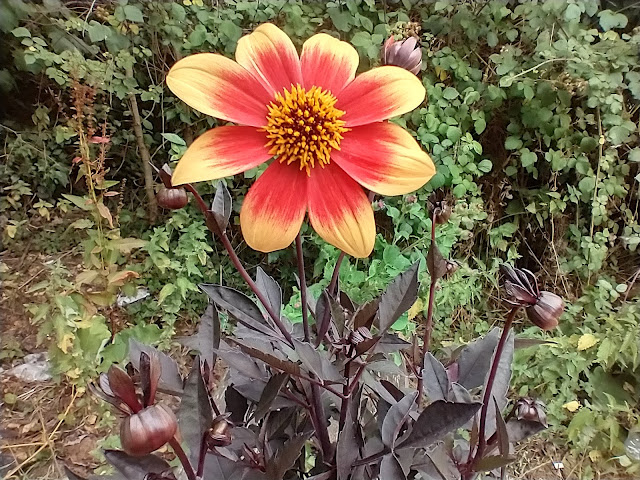An Evening With Dan Pearson

Last week Dan Pearson came to speak at the University of Bath Gardening Club. I first heard him last year when I won a ticket to the Hay Festival (see above picture). There he previewed his latest book Spirit (you can get a flavour of what he said from this YouTube video taken at Chicago last year), but this time we were promised a talk on the Millennium Forest.
We actually got three for the price of one as Dan chose to talk about some of the key projects he's been working on over the past few years. I was very happy as they're all projects in the public planting arena: Broughton Hall, Maggie's Centre and the aforementioned Millennium Forest.
If you take the above link to Dan Pearson's website, select Projects and then the Commercial option, you'll find that all three projects are featured on there and it'll give you a good idea of some of the slides we saw last Tuesday evening. Apologies for the slightly convoluted way of getting there, but unfortunately I can't seem to be able to locate a link that takes you directly to the pictures I'd like you to see.
Dan Pearson's approach is very much assessing the mood, heritage and surroundings of each place he is asked to design in addition to the client's brief. He likes to get to what he calls 'the sense of place', which aims to ensure that each design is not only individual, it also sits well with its surroundings. The results are usually very much in tune with what I'd like my own garden to be like.
Broughton Hall
Broughton Hall is in Yorkshire and Dan was asked to re-design the walled garden following the owner's restoration of the estate and the establishment of a number of offices for rent in the outbuildings, now housing some 500 people. I'm sure that most of us immediately think kitchen garden when a walled garden is mentioned, but this wasn't really appropriate for the estate's new users.
Instead the rolling hills of the surrounding landscape were established in miniature within the garden's walls to give a garden with both wide open spaces and intimate corners depending how sociable people want to be during their lunch breaks. In addition miniature versions of the drystone walls of the area's sheep folds surrounding small copses of trees were built closer to the main garden building. These formed a series of square spaces with a shady tree above and seating below. Quite a few of the trees bear fruit or are vines, the idea being that workers can pluck fresh fruit to accompany their lunch at certain times of the year. I would have dearly loved to have worked in place like this!
Maggie's Centre
This was a very different garden because it's in an urban setting in London and is designed as a healing garden for people suffering from cancer. The various Maggie's Centres in the UK are for anyone affected by cancer and offer psychological and practical support.
The first part of the design for the Maggie's Centre in London is of lots of trees surrounding the building. Dan explained that this was to give the perception of the building being embraced, thus underlining the supportive nature of the work undertaken at the centre. I also thought it was a good way of reducing traffic noise and thus helping to provide a calm atmosphere to the place.
Next there is the walk from the street into the centre. Lushly planted, it's also designed to have lots of succession planting to give highlights to the garden at regular intervals. Not only does this maintain interest, it also means that the centre's users see something inspiring, no matter how much time they actually have left.
Finally, the garden and building is designed so that every room has a view onto the garden. This again gives a calming influence to the place and also picks up on the studies which show that patients having access to views of greenery have a greater sense of well being and recover more quickly. It was interesting to note that Dan had a very close working relationship with the building's architects and that both building and garden combined were cited when Maggie's won the Stirling prize last year.
Tokachi Millennium Forest
The Millennium Forest is in Hakkaido, Japan (not the Midlands as I'd originally thought: I now realise I mistook it for The National Forest) where its owners wish to create a place to last for a thousand years. It's also meant to be an antidote to the intense farming of the surrounding landscape.
We were shown three aspects to the project: the first was the regeneration of the forest landscape, where the close ranks of spruce were being opened up to encourage the native vegetation slumbering beneath the forest floor below. This was having to be done quite carefully as bamboo tends to invade once the forest is cleared. It looked like around half of the trees were taken out leaving lines of them in place, with the bamboo then cleared at regular intervals until the native vegetation re-establishes itself.
The next section of the project was a re-design of a relatively level and featureless area which was re-shaped to echo the landforms of the surrounding hills. These were designed in such a way to encourage people to move through the landscape to discover its hidden features. Previously visitors had tended to stay put on reaching this area, and the owners wanted everyone to enjoy and interact more with the landscape.
The final piece was a large garden surrounding the forest's restaurant. Again, people were tending to go to the restaurant and stay there, so the garden was planned to encourage them to go for a walk after taking their refreshments. A mixture of native and non-native plants were chosen to give a garden much more English/prairie-style in its feel. Apparently 'English' gardens are very fashionable in Japan at the moment, thus people would want to explore the many routes available to them.
I was completely blown away by this project, as I don't know how I'd get my head round designing a landscape of more than 200 hectares, or indeed a planting plan for a garden involving 35,000 plants. But then I'm not Dan Pearson ;)
The evening was rounded off nicely by Dan signing my copy of Spirit (won courtesy of Constant Gardener's Christmas competition last year) and us chatting about how beautiful the Gower Peninsula is. It also transpires that he's just moved from London to the Bath area (hurrah!), to a place which in time will have a completely new garden. There's no hurry to start this long term project - as this beautifully written piece for The Observer a couple of weeks ago shows.










Broughton Hall is indeed a very lovely place and as perfect a workspace as you could think of.
ReplyDeleteGlad it went well - even though he had to give his talk in such a huge venue! he probably lost the sense of intimacy!
James - Broughton Hall was my favourite of the three. The room was packed - @EmmaB had to sit on the floor!
ReplyDeleteI love Dan Pearson's approach to landscaping and planting. I watched the series on Home Farm and was bewitched. Broughton looks serenely lovely. Thank you for the pointer to his article on moving, it made very restful and uplifting reading somehow.
ReplyDeletePlantaliscious - restful reading is a very good summary of that article :)
ReplyDelete